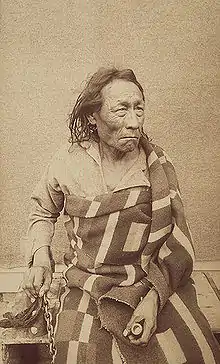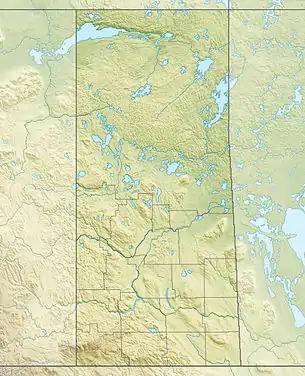North-West Rebellion
The North-West Rebellion of 1885 was a rebellion by the Métis people under Louis Riel and an associated uprising by First Nations Cree and Assiniboine of the District of Saskatchewan against the Canadian government. Many Métis felt that Canada was not protecting their rights, their land, and their survival as a distinct people.
| North-West Rebellion | |||||||
|---|---|---|---|---|---|---|---|
| Part of the American Indian Wars | |||||||
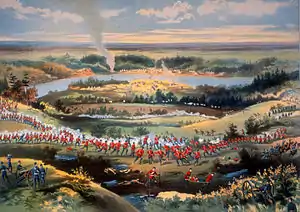 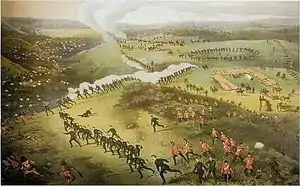 Top: Battle of Batoche Bottom: Battle of Cut Knife | |||||||
| |||||||
| Belligerents | |||||||
|
| |||||||
| Commanders and leaders | |||||||
| Strength | |||||||
| |||||||
| Casualties and losses | |||||||
| |||||||
Riel had been invited to lead the movement of protest. He turned it into a military action with a heavily religious tone. That alienated Catholic clergy, whites, most Indigenous tribes, and some Métis, but he had the allegiance of 200 armed Métis, a smaller number of other Indigenous warriors, and at least one white man at Batoche in May 1885, who confronted 900 Canadian militia and some armed local residents. About 91 people would die in the fighting that occurred that spring before the rebellion's collapse.[7][8][9]
Despite some notable early victories at Duck Lake, Fish Creek, and Cut Knife, the rebellion was quashed when overwhelming government forces and a critical shortage of supplies brought about the Métis' defeat in the four-day Battle of Batoche. The remaining Aboriginal allies scattered. Several native chiefs were captured, and some served prison time. Eight Natives were hanged in Canada's largest mass hanging for killings performed outside the military conflict.
Riel was captured, put on trial, and convicted of treason. Despite many pleas across Canada for clemency, he was hanged. Riel became a heroic martyr to Francophone Canada. That was one cause for the rise of ethnic tensions into a deep division, whose repercussions continue to be felt. The rebellion's suppression contributed to the present reality of the Prairie Provinces being controlled by English speakers, who allowed only a very limited francophone presence, and helped cause the alienation of French Canadians, who were embittered by the repression of their countrymen.[10][11][12] The key role that the Canadian Pacific Railway played in transporting troops caused support by the Conservative government to increase, and Parliament authorized funds to complete the country's first transcontinental railway.
Background
After the Red River Rebellion of 1869–1870, many of the Métis moved from Manitoba to the Fort Carlton region of the Northwest Territories, where they founded the Southbranch settlements of Fish Creek, Batoche, St. Laurent, St. Louis, and Duck Lake on or near the South Saskatchewan River.[13][14] In 1882, surveyors began dividing the land of the newly formed District of Saskatchewan in the square concession system. The Métis lands were laid out in the seigneurial system of strips reaching back from a river which the Métis were familiar with in their French-Canadian culture.[11] A year after the survey the 36 families of the parish of St. Louis found that their land and village site that included a church and a school (in Township 45, Range 7 west of the 2nd Meridian of the Dominion Land Survey) had been sold by the Government of Canada to the Prince Albert Colonization Company.[15][16] Not having clear title, the Métis feared losing their land which, now that the buffalo herds were gone,[17] was their primary source of sustenance.[12]
In 1884, the Métis (including the Anglo-Métis) asked Louis Riel to return from the United States, where he had fled after the Red River Rebellion, to appeal to the government on their behalf.[11] The government gave a vague response. In March 1885, Riel, Gabriel Dumont, Honoré Jackson (a.k.a. Will Jackson), and others set up the Provisional Government of Saskatchewan, believing that they could influence the federal government in the same way as they had in 1869.
The role of aboriginal peoples prior to—and during—the outbreak of the rebellion is often misunderstood. A number of factors have created the misconception that the Cree and Métis were acting in unison. By the end of the 1870s, the stage was set for discontent among the aboriginal people of the prairies: the bison population was in serious decline (creating enormous economic difficulties)[18] and, in an attempt to assert control over aboriginal settlement, the federal government often violated the terms of the treaties it had signed during the latter part of the decade.[19] Thus, widespread dissatisfaction with the treaties and rampant poverty spurred Big Bear, a Cree chief, to embark on a diplomatic campaign to renegotiate the terms of the treaties (the timing of this campaign happened to coincide with an increased sense of frustration among the Métis).[20] When the Cree initiated violence in the spring of 1885, it was almost certainly unrelated to the revolt of Riel and the Métis (which was already underway). In both the Frog Lake Massacre and the Siege of Fort Battleford, small dissident groups of Cree men revolted against the authority of Big Bear and Poundmaker.[21] Although he quietly signalled to Ottawa that these two incidents were the result of desperate and starving people and were, as such, unrelated to the rebellion, Edgar Dewdney, the lieutenant-governor of the territories, publicly claimed that the Cree and the Métis had joined forces.[22]
For Riel and the Métis, several factors had changed since the Red River Rebellion. The railway had been completed across the prairies in 1883, though sections were still under construction north of Lake Superior, making it easier for the government to get troops into the area. In addition, the North-West Mounted Police (NWMP) had been created, developing an armed local force. Riel lacked support from English settlers of the area as well as the great majority of tribes. Riel's claim that God had sent him back to Canada as a prophet caused Catholic officials (who saw it as heresy) to try to minimize his support. The Catholic priest, Albert Lacombe, worked to obtain assurances from Crowfoot that his Blackfoot warriors would not participate in a rebellion.[23]
Demographics
The District of Saskatchewan, part of the Northwest Territories in 1885, was divided into three sub-districts and had a population of 10,595. To the east, the Carrot River sub-district with 1,770 people remained quiet. The Prince Albert sub-district located in the centre of the district had a population of 5,373 which included the Southbranch settlements with about 1,300. The South branch settlement was the centre of Louis Riel's Provisional Government of Saskatchewan during the Rebellion. To the west, where the Cree uprising led by Poundmaker and Big Bear occurred, was the Battleford sub-district with 3,603 people.[14][24]
The largest settlement and the capital of the district was Prince Albert with about 800 people[25] followed by Battleford with about 500 people who were "divided about equally between French, Métis and English".[26]
The Métis population in Saskatchewan in 1885 was about 5,400. A majority tried to stay neutral in the dispute with the national government, as the priests recommended. About 350 armed men supported Riel.[27] A smaller number opposed him, led by Charles Nolin. In addition, he had the support of a small number of Indians. Riel's supporters included the older, less assimilated Métis, often with close associations with the Indian population. Many moved back and forth into Indian communities and preferred to speak Indian languages more than French. Riel's opponents were younger, better educated Métis; they wanted to be more integrated into Canadian society, not to set up a separate domain as Riel promised.[28]
Course of war
Riel had been invited in to lead the movement but he turned it into a military action with a heavily religious tone, thereby alienating the Catholic clergy, the whites, nearly all of the First Nations, and most of the Métis. He had a force of a couple hundred Métis and a smaller number of First Nations at Batoche in May 1885, confronting 900 government troops.[7][8]
Outbreak of rebellion
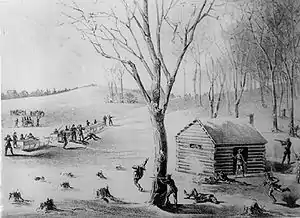
On March 26, 1885, the 150 to 200 Métis and Aboriginal warriors under the command of Gabriel Dumont defeated a combined group of 90 Prince Albert Volunteers and North-West Mounted Police led by their superintendent Leif Newry Fitzroy Crozier at Battle of Duck Lake, outside Batoche.[29] The federal government had, shortly before the battle at Duck Lake, sent Major General Frederick Middleton to the West. Eventually, over a period of many weeks, Middleton brought 3,000 troops to the West, and incorporated another 2,000, mostly English-Canadian volunteers, and 500 North-West Mounted Police into his force.[1]
On March 30, 1885, a raiding party of Cree people, short of food due to declining bison populations, approached Battleford. The inhabitants fled to the nearby North-West Mounted Police post, Fort Battleford. The Cree then took food and supplies from the empty stores and houses.[30] As well, Cree insurgents looted Hudson's Bay Company posts at Lac la Biche and Green Lake on April 26.[31]
On April 2, 1885, at Frog Lake, Saskatchewan (now in Alberta) a Cree raiding party led by Cree war chief, Wandering Spirit, attacked the small town. Angered by what seemed to be unfair treaties and the withholding of vital provisions by the Canadian government, and also by the dwindling buffalo population, their main source of food, Big Bear and his Cree decided to rebel after the successful Métis victory at Duck Lake. They gathered all the white settlers in the area into the local church. They killed Thomas Quinn, the town's Indian agent, after a disagreement broke out. The Cree then attacked the settlers, killing eight more and taking three captive.[5][32][33]
The massacre prompted the Canadian government to take notice of the growing unrest in the North-West Territories. When the rebellion was put down, the government hanged Wandering Spirit, the war chief responsible for the Frog Lake Massacre.
On April 15, 1885, 200 Cree warriors descended on Fort Pitt. They intercepted a police scouting party, killing a constable, wounding another, and captured a third. Surrounded and outnumbered, garrison commander Francis Dickens capitulated and agreed to negotiate with the attackers. Big Bear released the remaining police officers but kept the townspeople as hostages and destroyed the fort. Six days later, Inspector Dickens and his men reached safety at Battleford.[34]
Government mobilization
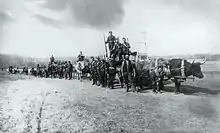
Recognizing that an uprising might be imminent, the federal government had, three days before Duck Lake, sent Major General Frederick Middleton, the commander of the Canadian Militia, to Winnipeg, where a unit of militia, the 90th Winnipeg Rifles, and of militia artillery, the Winnipeg Field Battery, already existed. After Duck Lake, the government immediately commenced the mobilization of some of Canada's ill-equipped part-time militia units (the Non-Permanent Active Militia), as well as the units of cavalry, artillery and infantry regulars that made up the tiny Permanent Active Militia, Canada's almost-nonexistent regular army. By March 30, after hasty mobilization in Toronto, two trains containing the 10th Royal Grenadiers and Queen's Own Rifles militia battalions were ready to leave Toronto. Other militia units, the 9th Voltigeurs from Quebec City, and the 65th Mount Royal Rifles from Montreal, were also quickly mobilized. Soon every major city in the East was the scene of embarkation for inexperienced young militiamen cheered by immense crowds.
The first militia to struggle westward had to contend with the many lengthy breaks in the CPR line in northern Ontario. They marched through snow, or were carried in exposed sleighs. Where there were short stretches of track, the militia rode on hastily-constructed railroad flatcars which did nothing to shelter them from the extreme cold. Many of the soldiers suffered greatly from the winter weather. However, the first troops sent west were, in succeeding weeks, followed by thousands more.[35]
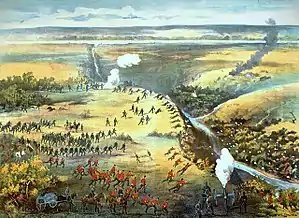
Other forces such as the Alberta Field Force led by Thomas Bland Strange were formed in the West.
April–May Metis victories
On April 24, 1885, at Fish Creek, Saskatchewan, 200 Métis achieved a remarkable victory over a superior government force numbering 900 soldiers who were sent to quell the rebellion. The reversal, though not decisive enough to alter the outcome of the war, temporarily halted Major General Frederick Middleton's column's advance on Batoche. That was where the Métis would later make their final stand.[36]
On May 2, 1885, the Cree war chief Fine-Day successfully held off Lieutenant Colonel William Otter at the Battle of Cut Knife near Battleford. Despite its use of a gatling gun, a flying column of Canadian militia was forced to retreat. Fine-Day was affiliated with the chief Poundmaker. Big Bear did not get involved.[37][38]
Ending the rebellion
On May 9, 1885, Middleton attacked Batoche itself. The greatly outnumbered Métis ran out of ammunition after three days of battle and siege. The Métis resorted to firing sharp objects and small rocks from their guns, until they were killed or dispersed when Middleton's soldiers advanced in strength and overran their rifle pits. Riel surrendered on May 15. Gabriel Dumont and other participants escaped across the border to the Montana Territory of the United States.[39] The defeat of the Métis and Riel's capture led to the collapse of the Provisional Government.

But the downfall of Batoche did not end the conflict.
By May 28, 1885, Major General Thomas Bland Strange brought a force of militia, including a NWMP detachment, from Calgary, Alberta, into contact with a fleeing Cree force under Big Bear. The Native fighters carried the day at Frenchman's Butte in a battle at the end of May.[40]
The last armed engagement in the rebellion was the Battle of Loon Lake. On June 3, 1885, a small detachment of NWMP under the command of Major Sam Steele caught up to Big Bear's force which was moving northward after their victory at Frenchman's Butte. Big Bear's fighters were almost out of ammunition, and fled after a short exchange of fire and the release of their hostages.[41]
Demoralized, defenceless, and with no hope of relief after the surrender of Riel's forces at Batoche and Poundmaker's defeat, most of Big Bear's fighters surrendered over the next few weeks. On July 2 Big Bear surrendered to the NWMP on an island in the Saskatchewan River near Fort Carlton. The government addressed the critical food shortage of the Cree and Assiniboine by sending food and other supplies. Poundmaker and Big Bear were sentenced to prison. Eight others were hanged in the largest mass hanging in Canadian history.[42] These individuals, found guilty of killing outside of the military conflict, were Wandering Spirit, (Kapapamahchakwew) a Plains Cree war chief, Little Bear (Apaschiskoos), Walking the Sky (AKA Round the Sky), Bad Arrow, Miserable Man, Iron Body, Ika (AKA Crooked Leg) and Man Without Blood, for murders committed at Frog Lake and at Battleford (the murders of Farm instructor Payne and Battleford farmer Barney Tremont).
Aftermath
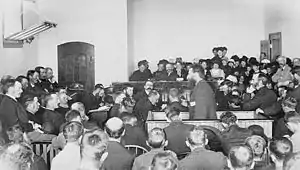
The trial of Louis Riel occurred shortly after the rebellion, where he was found guilty of high treason, and hanged. His trial sparked a national controversy between English and French Canada.[12]
The Canadian Pacific Railway (CPR) played a key role in the government's response to the Rebellion, as it was able to transport federal troops to the area quickly. While it had taken three months to get troops to the Red River Rebellion, the government was able to move forces in nine days by train in response to events in the North-West Territories. The successful operation increased political support for the floundering and incomplete railway, which had been close to financial collapse. The government authorized enough funds to finish the line. Thus, Prime Minister John A. Macdonald was able to realize his National Dream of linking Canada across the continent.
After the fighting, new Territorial Council ridings were created in the Territories, although still only covering specific areas of concentrated settlement. The North-West Territories election of 1885 was held. The Scrip Commission was dispatched to the District of Saskatchewan and to present-day Alberta to address Métis land claims.[43][44]
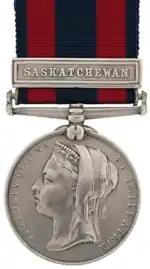

The Rebellion was Canada's first independent military action. It cost about $5 million, and lost the Conservative Party most of their support in Quebec. It guaranteed Anglophone control of the Prairies, and demonstrated the national government was capable of decisive action.[45] Those who served with the Militia and Police during the rebellion received the North West Canada Medal, established in September 1885.[46]
Long-term consequences
The Saskatchewan Métis' requested land grants; they were all provided by the government by the end of 1887, and the government resurveyed the Métis river lots in accordance with their wishes. The Métis did not understand the long term value of their new land, however, and sold much of it to speculators who later resold it to farmers. The French language and Catholic religion faced increasing marginalisation in both Saskatchewan and Manitoba, as exemplified by the emerging controversy surrounding the Manitoba Schools Question. The Métis themselves were increasingly forced to live on undesirable land or in the shadow of Indian reserves (as they did not themselves have treaty status as Indians with a right to land).
Riel's trial and Macdonald's refusal to commute his sentence caused lasting upset in Quebec, and led to a fundamental francophone distrust of Anglophone politicians. French Canada felt it had been unfairly targeted.[48]
Memory
In the spring of 2008, Tourism, Parks, Culture and Sport Minister Christine Tell proclaimed in Duck Lake, that "the 125th commemoration, in 2010, of the 1885 Northwest Rebellion is an excellent opportunity to tell the story of the prairie Métis and First Nations peoples' struggle with Government forces and how it has shaped Canada today."[49]
Historic Sites and Monuments board of Canada.[50]
Batoche, where a Métis Provisional Government had been formed, has been declared a National Historic Site. Batoche marks the site of Gabriel Dumont's grave site, Albert Caron's House, Batoche school, Batoche cemetery, Letendre store, Dumont's river crossing, Gariépy's crossing, Batoche crossing, St. Antoine de Padoue Church, Métis rifle pits, and RNWMP battle camp.[51][52]
Fort Carlton Provincial Historic site has been rebuilt as it had been ravaged by three separate fires. Big Bear (Mistahimaskwa) had used the site in his initial negotiations for Treaty Six in about 1884, and finally, the following year he surrendered here after his engagement at Steele Narrows.[53][54] The Prince Albert blockhouse was employed by the North-West Mounted Police on evacuating from Fort Carlton after the first fire.[55] Duck Lake is home to the Duck Lake Historical Museum and the Duck Lake Regional Interpretive Centre, and murals which reflect the history of the Rebellion in the area. The Battle of Duck Lake, the Duck Lake Massacre, and a buffalo jump are all located here. The "First Shots Cairn" was erected on Saskatchewan Highway 212 as a landmark commemorating the scene of the first shots in the Battle of Duck Lake. The Our Lady of Lourdes Shrine at St. Laurent north of Duck Lake is a local pilgrimage site.[56][57][58][59] The Battle of Fish Creek National Historic Site, the name has been changed to Tourond's Coulee / Fish Creek National Historic Site to preserve the battlefield of April 24, 1885, at la coulée des Tourond, Madame Tourond's home, early Red River cart Fish Creek Trail and the site of Middleton's camp and graveyard.[60]
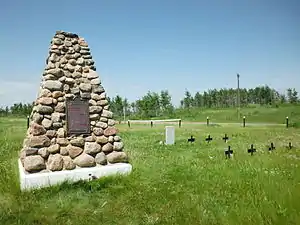
The Marr Residence is a municipal heritage property of Saskatoon which served as a field hospital for wounded soldiers of the rebellion.[61][62][63] Fort Otter was constructed at Battleford's government house located at the capital of the North-West Territories. Poundmaker was arrested at Fort Battleford and sentenced to a prison term. Eight First Nations men were hanged, five due to participation in the Frog Lake Massacre, two for murders in the Battleford area, and one for the killing of a Mountie at Fort Pitt on April 15.[64] Fort Battleford has been declared a National Historic site of Canada to commemorate its role as military base of operations for Cut Knife Hill, Fort Pitt, as a refuge for 500 area settlers and its role in the Siege of Battleford.[55][65][66][67] Fort Pitt, the scene of the Battle of Fort Pitt, is a Provincial Park and National Historic site where a National Historic Sites and Monuments plaque designates where Treaty Six was signed.[68][69][70] Frog Lake Massacre National Historic Site of Canada, at Frog Lake, Alberta, is the location of a Cree uprising that occurred in the District of Saskatchewan North-west Territories.[71] Frenchman Butte is a National Historic Site of Canada. It is the location of an 1885 battle between Cree and Canadian troops.[72][73]
National Historic Sites and Monuments Board[74]
At Cutknife is the world's largest tomahawk, the Poundmaker Historical Centre and Big Bear monument erected by cairn erected by the Historic Sites and Monuments Board of Canada. There is also now, correctly located, a cairn erected upon Cut Knife Hill the look site of the Poundmaker Battle site and Battle River valley.[75][76][77][78] The Narrows between Makwa Lake and Sanderson Bay, in the Makwa Lake Provincial Park, was the site of the last engagement of the rebellion. Steele Narrows Provincial Historic Park conserves the lookout point of a Cree burial ground.[79][80] The Royal Canadian Mounted Police training depot at Regina was established in 1874, and still survives. The RCMP chapel, a frame building built in 1885, is still standing. It was used to jail Indian prisoners. One of three Territorial Government Buildings remains on Dewdney Avenue in the provincial capital city of Regina which was the site of the Trial of Louis Riel, where the drama the Trial of Louis Riel is still performed. Following the May trial, Louis Riel was hanged November 16, 1885. The RCMP Heritage Centre, in Regina, opened in May 2007.[81][82][83] The Métis brought his body to Saint-Vital, his mother's home, now the Riel House National Historic Site, and then interred it at the Saint-Boniface Basilica in Manitoba, his birthplace, for burial.[84][85] Highway 11, stretching from Regina to just south of Prince Albert, has been named Louis Riel Trail by the province; the roadway passes near locations of the 1885 rebellion.[86]

The members of the Canadian Militia are commemorated through a number of memorials in Canada, including the North-West Rebellion Monument in Queen's Park, in Toronto, Ontario, and The Volunteer Monument in Winnipeg, Manitoba. A statue for Wm. B. Osgoode and John Rogers, who fell in action at Cutknife Hill, also stands at the Cartier Square Drill Hall, in Ottawa, Ontario.
However, the militiamen who died during the 1885 North-West Rebellion are not commemorated in either the Books of Remembrance in the Memorial Chamber of the Parliament Buildings in Ottawa or in Canada's Virtual War Memorial, both of which are administered by Veterans Affairs Canada.[87] North-West Mounted Police members who lost their lives during 1885 are commemorated in the RCMP Book of Remembrance. The 1885 North-West Canada casualties are the only group of service-members who died in the service of Canada since Confederation not memorialized in this way.
In fiction
- Stewart Sterling's Red Trails (1935) depicted the pulp hero Eric Lewis, a Mountie of the Royal Northwest Mounted Police. He tries to keep "peace and order" during the North-West Rebellion, helped by Sergeant Tim Clone.[88]
- North West Mounted Police, by Cecil B. DeMille (1940). The film is about a Texas Ranger who joins forces with the North-West Mounted Police to put down the rebellion.
- The Magnificent Failure (1967) by Giles Lutz is a historical novel of the North-West Rebellion.
- Lord of the Plains, by Albert Silver, c 1990, Ballantine Books. Spur Award Finalist. Focuses on Gabriel Dumont and his family.
- The novel for young adults called Battle Cry at Batoche (1998), by B. J. Bayle, portrays the events of the North-West Resistance from a Métis point of view.
- Song of Batoche, by Maia Caron (Ronsdale Press: 2017), a historical novel centered on the North-West Rebellion through the perspectives of Métis women, Gabriel Dumont, Louis Riel, and others involved.[89]
See also
References
- Panet, Charles Eugène (1886), Report upon the suppression of the rebellion in the North-West Territories and matters in connection therewith, in 1885: Presented to Parliament., Ottawa: Department of Militia and Defence, retrieved 2014-04-10
- Mulvaney, Charles Pelham (1885), The history of the North-West Rebellion of 1885 (The Troops in the Field), Toronto: A.H. Hovey & Co, p. 422, retrieved 2014-04-10
- Panet, Charles Eugène (1886), Report upon the suppression of the rebellion in the North-West Territories and matters in connection therewith, in 1885: Presented to Parliament.(p.20), Ottawa: Department of Militia and Defence, retrieved 2014-04-10
- Panet, Charles Eugène (1886), Report upon the suppression of the rebellion in the North-West Territories and matters in connection therewith, in 1885: Presented to Parliament., Ottawa: Department of Militia and Defence, retrieved 2014-04-10
- John Chaput (2007). "Frog Lake Massacre". The Encyclopedia of Saskatchewan. University of Regina and Canadian Plains Research Center. Archived from the original on 4 September 2009. Retrieved 8 June 2010.
- Mulvaney, Charles Pelham (1885), The history of the North-West Rebellion of 1885 p.327, Toronto: A.H. Hovey & Co, retrieved 2014-04-10
- James Rodger Miller (2004). Reflections on Native-newcomer Relations: Selected Essays. University of Toronto Press. p. 44.
- Thomas Flanagan, Riel and the Rebellion: 1885 Reconsidered (2000) pp 3-4
- Robert MacIntosh, Boilermakers on the Prairies, p. 16
- J. M. Bumsted, The Peoples of Canada: A Post-Confederation History (1992), pp xiii, 31
- "North-west resistance". Encyclopedia of Saskatchewan. Canadian Plains Research Center, University of Regina. 2006. Archived from the original on 2014-01-08. Retrieved 2013-09-17.
- "The Quebec History Encyclopedia (North-West Rebellion)". The Quebec History Encyclopedia. Claude Bélanger, Marianopolis College. 2007. Retrieved 2013-11-19.
- Henry Thomas McPhillips (1888), McPhillips' alphabetical and business directory of the district of Saskatchewan, N.W.T.: Together with brief historical sketches of Prince Albert, Battleford and the other settlements in the district, 1888 (pages 93-97), Prince Albert, NWT: Henry Thomas McPhillips, retrieved 2014-04-10
- "FRENCH AND MÉTIS SETTLEMENTS". Encyclopedia of Saskatchewan. Canadian Plains Research Center, University of Regina. 2006. Archived from the original on 2013-11-09. Retrieved 2013-09-17.
- "North West Rebellion". The Globe (Toronto). 1885-12-26. Retrieved 2013-12-11.
- Richard Cole Harris; Geoffrey J. Matthews; R. Louis Gentilcore (1987). Historical Atlas of Canada: The land transformed, 1800-1891. University of Toronto Press. p. 93. ISBN 978-0-8020-3447-2. Retrieved 2014-04-10.
- John Elgin Foster; Dick Harrison; I. S. MacLaren (1 January 1992). Buffalo. University of Alberta. pp. 73–74. ISBN 978-0-88864-237-0.
- James Rodger Miller (2000). Skyscrapers Hide the Heavens: A History of Indian-white Relations in Canada. University of Toronto Press. p. 171. ISBN 978-0-8020-8153-7.
- Miller, J. R. Skyscrapers Hide The Heavens: A History of Indian-White Relations in Canada. Toronto: University of Toronto Press, 1989. 174.
- Friesen, Gerald. The Canadian Prairies: A History. Toronto: University of Toronto Press, 1984. 226.
- J. R. Miller, Skyscrapers Hide The Heavens: A History of Indian-White Relations in Canada (University of Toronto Press, 1989) p. 182.
- Arthur J. Ray, I Have Lived Here Since The World Began: An Illustrated History of Canada's Native People (Toronto: Key Porter Books, 2005) p 221.
- Dempsey, Hugh A. (1957). The Early West. Edmonton: Historical Society of Alberta. p. 21. Archived from the original on 2015-09-04. Retrieved 2013-10-26.
- Henry Thomas McPhillips (1888), McPhillips' alphabetical and business directory of the district of Saskatchewan, N.W.T.: Together with brief historical sketches of Prince Albert, Battleford and the other settlements in the district, 1888 (page 23), Prince Albert, NWT: Henry Thomas McPhillips, retrieved 2014-04-10
- Henry Thomas McPhillips (1888), McPhillips' alphabetical and business directory of the district of Saskatchewan, N.W.T.: Together with brief historical sketches of Prince Albert, Battleford and the other settlements in the district, 1888 (p. 65), Prince Albert, NWT: Henry Thomas McPhillips, retrieved 2014-04-10
- Henry Thomas McPhillips (1888), McPhillips' alphabetical and business directory of the district of Saskatchewan, N.W.T.: Together with brief historical sketches of Prince Albert, Battleford and the other settlements in the district, 1888 (p. 53), Prince Albert, NWT: Henry Thomas McPhillips, retrieved 2014-04-10
- D.N. Sprague (1988). Canada and the Métis, 1869-1885. Wilfrid Laurier Univ. Press. pp. 164, 173. ISBN 9780889209589.
- David Lee, "The Metis militant rebels of 1885." Canadian Ethnic Studies/ Etudes ethniques au Canada (1989) 21#3 pp 1+
- Mulvaney, Charles Pelham (1885), The history of the North-West Rebellion of 1885 (The Duck Lake Disaster) p.30, Toronto: A.H. Hovey & Co, retrieved 2014-04-10
- Mulvaney, Charles Pelham (1885), The history of the North-West Rebellion of 1885 (The War Cloud Bursts on Battleford) p.76, Toronto: A.H. Hovey & Co, retrieved 2014-04-10
- Beal and Macleod, Prairie Fire, pp. 234–235
- Dempsey, Hugh A. (1957). The Early West. Edmonton: Historical Society of Alberta. p. 1. Archived from the original on 2015-09-04. Retrieved 2014-04-10.
- William Bleasdell Cameron (1888), The war trail of Big Bear (The Frog Lake Massacre), Toronto: Ryerson Press (published 1926), retrieved 2014-04-10
- William Bleasdell Cameron (1888), The war trail of Big Bear (The Fall of Fort Pitt), Toronto: Ryerson Press (published 1926)
- Beal, Bob and Macleod, Rod, Prairie Fire: the 1885 North-West Rebellion, McClelland and Stewart, Toronto, 1994, pp. 168-177
- Mulvaney, Charles Pelham (1885), The history of the North-West Rebellion of 1885 (The Battle of Fish Creek) p.127, Toronto: A.H. Hovey & Co, retrieved 2014-04-10
- Mulvaney, Charles Pelham (1885), The history of the North-West Rebellion of 1885 (The Battle of Cut Knife Creek) p.156, Toronto: A.H. Hovey & Co, retrieved 2014-04-10
- Panet, Charles Eugène (1886), Report upon the suppression of the rebellion in the North-West Territories and matters in connection therewith, in 1885: Presented to Parliament., Ottawa: Department of Militia and Defence, retrieved 2014-04-10
- Mulvaney, Charles Pelham (1885), The history of the North-West Rebellion of 1885 (The Battle at Batoche's Ferry) p.197, Toronto: A.H. Hovey & Co
- William Bleasdell Cameron (1888), The war trail of Big Bear (The Battle of Frenchman's Butte), Toronto: Ryerson Press (published 1926)
- William Bleasdell Cameron (1888), The war trail of Big Bear (Battle of Loon Lake), Toronto: Ryerson Press (published 1926); Myrna Kostash, The Frog Lake Reader
- William Bleasdell Cameron (1888), The war trail of Big Bear (The Indian Trials), Toronto: Ryerson Press (published 1926)
- "Northwest "Half-breed" Scrip". Métis National Council Historical Database. Archived from the original on 2014-12-03. Retrieved 2013-11-21.
- "Our Legacy (Metis Scrip)". University of Saskatchewan. Retrieved 2013-11-21.
- Flanagan, Riel and the Rebellion: 1885 Reconsidered (2000) pp 4-8
- Joslin, Litherland and Simpkin (1988). British Battles and Medals. London: Spink. pp. 165–6. ISBN 0907605257.
- Read, Geoff; Webb, Todd (2012). "The Catholic Mahdi of the North West': Louis Riel and the Metis Resistance in Transatlantic and Imperial Context". Canadian Historical Review. 93 (2): 171–195. doi:10.3138/chr.93.2.171.
- Mason Wade, The French Canadians: 1760-1967 (1968) 1:416-23
- "Tourism agencies to celebrate the 125th anniversary of the Northwest Resistance/Rebellion". Home/About Government/News Releases/June 2008. Government of Saskatchewan. June 7, 2008. Archived from the original on October 21, 2009. Retrieved 2009-09-20.
- Historic Sites and Monuments board of Canada. Government of Canada (21 Nov 2004). "Welcome To Saskatoon, Saskatchewan Region Gen Web Batoche / Fish Creek Photo Gallery". Saskatoon Gen Web. online by Julia Adamson. Retrieved 2009-09-20.
- "Batoche The Virtual Museum of Métis History and Culture". Gabriel Dumont Institute of Native Studies and Applied Research. Retrieved 2009-09-20.
- "Parks Canada Batoche National Historic Site of Canada". Government of Canada. 2009-06-22. Retrieved 2009-09-20.
- "Fort Carlton Provincial Park – Tourism, Parks, Culture and Sport -". Government of Saskatchewan. Archived from the original on 2009-07-24. Retrieved 2009-09-20.
- "Virtual Saskatchewan – Fur Trading at Fort Carlton". 1997–2007. Retrieved 2009-09-20.
- Payette, Pete; Phil Payette (2006). "Saskatchewan Forts: Northwest Rebellion". 2006 American Forts Network. Retrieved 2009-09-20.
- "History of Duck Lake and Area". Duck Lake Regional Interpretive Centre. Archived from the original on 2008-08-20. Retrieved 2009-09-20.
- "Attractions and Tourism – Town of Duck Lake, Saskatchewan". M.R. Internet. Town of Duck Lake. 2007. Archived from the original on 2009-12-13. Retrieved 2009-09-20.
- McLennan, David (2006). "Duck Lake – The Encyclopedia of Saskatchewan". Canadian Plains Research Center University of Regina. Archived from the original on 2012-11-06. Retrieved 2009-09-20.
- "Battleford, Batoche & Beyond tour along the Yellowhead Highway". Yellowhead IT! Travel Magazine. Yellowhead Highway Association. Retrieved 2009-09-20.
- "Parks Canada". Battle of Tourond's Coulee / Fish Creek National Historic Site of Canada. Retrieved 2009-09-20.html
- "Municipal Heritage Properties – Marr Residence". City of Saskatoon – Development Services Branch. 2007. Archived from the original on 2008-05-25. Retrieved 2009-03-20.
- Men of the city, Committee of the Historical Association of Saskatoon (30 January 2005). "Saskatoon Gen Web Project – Narratives of Saskatoon 1882-1912" (Published online Julia Adamson). University of Saskatchewan Book store. Retrieved 2009-09-20.
- "The Marr Residence". Retrieved 2014-04-10.
- Beal and Macleod, Prairie Fire, p. 332
- "Saskatchewan settlement experience". 1880-1890 – North-west Rebellion The 'siege of Battleford' as reported in the Saskatchewan Herald. Saskatchewan Archives Board Site by OH! Media – Regina Web Design. 2005. Archived from the original on 2011-07-16. Retrieved 2009-09-20.
- "Parks Canada – Fort Battleford National Historic Site – History". Government of Canada. 2009-06-22. Retrieved 2009-09-20.
- Yanko, Dave (1997–2007). "Virtual Saskatchewan – Fort Battleford National Historic Site". Retrieved 2009-09-20.
- "Fort Pitt Provincial Park – Tourism, Parks, Culture and Sport". Government of Saskatchewan. Archived from the original on 2009-04-15. Retrieved 2009-09-20.
- "Fort Pitt Provincial Park". Retrieved 2014-04-10.
- Beal, Bob (1 September 2007). "Fort Pitt". Historica-Dominion. The Canadian Encyclopedia Historica foundation. Archived from the original on June 7, 2011. Retrieved 2009-09-20.
- "Parks Canada – National Historic Sites in Alberta – National Historic Sites in Alberta". Government of Canada. Archived from the original on 2011-06-05. Retrieved 2009-09-20.
- "Parks Canada – National Historic Sites of Canada – administered by Parks Canada". Government of Canada. 2009-01-20. Archived from the original on 2011-06-05. Retrieved 2009-09-20.
- Chaput, John (2006). "Frog Lake Massacre". Canadian Plains Research Center University of Regina. Archived from the original on 2009-09-04. Retrieved 2009-09-20.
- "Our Legacy". University of Saskatchewan Archives, University of Saskatchewan Library, and Pahkisimon Nuye?ah Library System. 2008. Retrieved 2009-09-20.
- Brown., Brian M (July 4, 2002). "Poundmaker Historical Centre and Big Bear monument". Retrieved 2009-09-20.
- McLennan, David (2006). "Cut Knife". Canadian Plains Research Center University of Regina. Archived from the original on 2012-09-11. Retrieved 2009-09-20.
- Yanciw, David (August 10, 2001). "Town of Cut Knife, Saskatchewan". Big Things of Saskatchewan. Archived from the original on October 6, 2009. Retrieved 2009-09-20.
- Davidson, Keith (2002). "Everyone Chuckled – A Rebellion Story Taking From Keith Davidson's "Looking Back Series"". Saskatchewan Indian First Nations Periodical Index Search Winter 2002 v31 n01 p15. Archived from the original on December 10, 2008. Retrieved 2009-09-20.
- "Steele Narrows Provincial Park". Retrieved 2014-04-10.
- "Makwa". Sasl Biz community profiles. Enterprise Saskatchewan Government of Saskatchewan. Retrieved 2009-09-20.
- "Regina History Guide Tour". Saskatchewan Genealogical Society – Regina Branch. Retrieved 2009-09-20.
- "RCMP traditions centre in Regina". Top News Stories Beginnings and Landmarks. Leader-Post. May 16, 1955. p. 13. Archived from the original (republished online Saskatchewan News Index 1884-2000 University of Saskatchewan Libraries.) on 2008-10-05. Retrieved 2009-09-20.
- "History of the Royal Canadian Mounted Police". Mounted Police Post. Archived from the original on 2009-05-26. Retrieved 2009-09-20.
- "Explore Our Heritage; Louis Riel 1844–1885". CHTS Home Manitoba Heritage Council Commemorative Plaques. Government of Manitoba. Retrieved 2009-09-20.
- "Manitoba History Red River Resistance". Number 29, Spring 1995. Manitoba Historical Society. 1998–2009. Retrieved 2009-09-20.
- "Scenic Routes – The Louis Riel Trail". Tourism Saskatchewan. Government of Saskatchewan. Archived from the original on 2005-08-24. Retrieved 2007-09-24.
- http://www.veterans.gc.ca/eng/remembrance/memorials/books, and http://www.veterans.gc.ca/eng/remembrance/memorials/canadian-virtual-war-memorial Retrieved 7 April 2018.
- See https://web.archive.org/web/20091027131214/http://www.geocities.com/jjnevins/pulpsl.html
- Caron, Maia (August 2, 2017). "Song of Batoche". CBC Books.
Further reading
- Barkwell, Lawrence J. Veterans and Families of the 1885 Northwest Resistance (Saskatoon: Gabriel Dumont Institute, 2011) ISBN 978-1-926795-03-4
- Barkwell, Lawrence J. (2005), Batoche 1885: The Militia of the Metis Liberation Movement, Winnipeg: Manitoba Metis Federation, ISBN 0-9683493-3-1
- Barrett, Matthew. "'Hero of the Half-Breed Rebellion': Gabriel Dumont and Late Victorian Military Masculinity." Journal of Canadian Studies/Revue d'études canadiennes 48#3 (2014): 79–107.
- Beal, Bob & Macleod, Rod (1984), Prairie Fire: The 1885 North-West Rebellion, Toronto: McClelland & Stewart, ISBN 978-0-7710-1109-2
- Flanagan, Thomas (2000), Riel and the Rebellion: 1885 Reconsidered (2nd ed.), Toronto: University of Toronto Press, ISBN 0-8020-4708-4
- Mulvany, Charles Pelham (1886), The History of the North-west Rebellion of 1885, Toronto: A.H. Hovey & Co.
- Morton, Desmond (1972), The last war drum: the North West campaign of 1885, Toronto: Hakkert, ISBN 0-88866-512-1, military history
- Stonechild, Blair & Waiser, Bill (1997), Loyal Till Death: Indians and the North-West Rebellion, Calgary: Fifth House, ISBN 1-895618-88-6
- Thistle, Jesse. "The 1885 Northwest Resistance: Causes to the Conflict." HPS History and Political Science Journal 3 (2014). online
- Wade, Mason. The French Canadians; 1760-1967: vol 2: 1911–1967 (1968) pp 393–446 online
- Waite, Peter B. Canada 1874-1896 (McClelland & Stewart, 1978), pp 146–74
Historiography
- Dick, Lyle. "Nationalism and Visual Media in Canada: The Case of Thomas Scott's Execution." Manitoba History (Autumn/Winter2004-05), Issue 48, pp 2–18. online
- R. Douglas Francis; Richard Jones; Donald B. Smith (2009). Journeys: A History of Canada. Cengage Learning. pp. 306–7. ISBN 978-0176442446., short summary of historians' views
- Lee, David. "The Metis militant rebels of 1885." Canadian Ethnic Studies/ Etudes Ethniques au Canada (1989) 21#3 pp 1+ online
- Miller, J. R. "From Riel to the Metis." Canadian Historical Review 69#1 (1988): 1–20.
- James Rodger Miller, "From Riel to the Métis" (2004). Reflections on Native-newcomer Relations: Selected Essays. University of Toronto Press. pp. 37–60., historiography
- Morton, Desmond. "Image of Louis Riel in 1998," Canadian Speeches (May 1998) 12#2 online
- Reid, Jennifer; Long, Charles & Carrasco, David (2008), Louis Riel and the Creation of Modern Canada: Mythic Discourse and the Postcolonial State, Albuquerque: University of New Mexico Press, ISBN 978-0-8263-4415-1
- Sprague, D.N. (1988). Canada and the Métis, 1869-1885. Wilfrid Laurier Univ. Press. ISBN 9780889209589.
- Stanley, George F.G. Louis Riel: Patriot or Rebel? Canadian Historical Association Booklet No. 2 (1979) online
External links
| Wikimedia Commons has media related to North-West Rebellion. |
